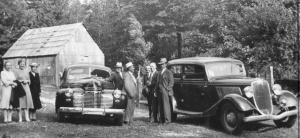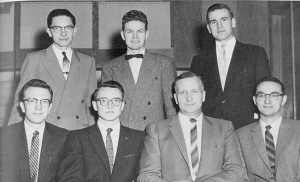Difference between revisions of "West Coast Children’s Mission of British Columbia"
| [checked revision] | [checked revision] |
GameoAdmin (talk | contribs) (CSV import - 20130823) |
m (Added hyperlink.) |
||
| Line 1: | Line 1: | ||
| − | [[File:WCCMPioneerMtg.jpg|300px|thumb|right|''The first committee meeting at Harrison Mills, 1943. | + | [[File:WCCMPioneerMtg.jpg|300px|thumb|right|''The first committee meeting at Harrison Mills, 1943.<br /> |
| − | + | Mrs. Abe Esau, Mrs. Sylvester Dirks, Mrs. G. H. Sukkau, Klaas Enns, G. H. Sukkau, A. J. Stobbe, Peter Esau and Abe Esau.<br /> | |
| − | Mrs. Abe Esau, Mrs. Sylvester Dirks, Mrs. G. H. Sukkau, Klaas Enns, | + | Source: Mennonite Historical Society of British Columbia Archives'']] |
| − | + | Work among children in areas beyond the [[Mennonite Brethren Church|Mennonite Brethren]] (MB) congregations in the [[Fraser Valley (British Columbia, Canada)|Fraser Valley]] of [[British Columbia (Canada)|British Columbia]] (BC) was initiated at about the same time in both [[Abbotsford (British Columbia, Canada)|Abbotsford]] and Yarrow. Abbotsford’s interest was sparked by graduates of the [[Bethany College (Hepburn, Saskatchewan, Canada)|Bethany Bible School]] in Hepburn, Saskatchewan and its [[Western Children's Mission|Western Children’s Mission]] (WCM), organized as a society. This influence was strong enough to influence [[Enns, Klaas (1880-1955)|Klaas Enns]], [[Ewert, Peter F. (1900-1988)|Peter Ewert]], and [[Stobbe, Abraham J. (1905-1981)|Abe J. Stobbe]] to model their work on that Mission and call it the "West Coast Mission of British Columbia." | |
| − | G. H. Sukkau, A. J. Stobbe, Peter Esau and Abe Esau. | ||
| − | |||
| − | Source: Mennonite Historical Society of British Columbia Archives'']] | ||
Yarrow’s outreach to children was led mostly by persons who had attended [[Winkler Bible Institute (Winkler, Manitoba, Canada)|Winkler Bible School]]. Teachers and students there were strongly influenced by the Canadian Sunday School Mission. From beginnings in 1939 Yarrow’s outreach was directed by its committee for <em>Randmission </em>(outreach in outlying communities). After [[Sukkau, Gerhard H. (1903-1965)|George H. Sukkau]] came to Yarrow in 1940 to teach at [[Elim Bible School (Yarrow, British Columbia, Canada)|Elim Bible School]], it was possible in 1945 to bring the Yarrow and Abbotsford groups together and accept the work as the outreach arm of the [[British Columbia Conference of Mennonite Brethren Churches|British Columbia Conference of Mennonite Brethren Churches]] under the name West Coast Children’s Mission (WCCM). | Yarrow’s outreach to children was led mostly by persons who had attended [[Winkler Bible Institute (Winkler, Manitoba, Canada)|Winkler Bible School]]. Teachers and students there were strongly influenced by the Canadian Sunday School Mission. From beginnings in 1939 Yarrow’s outreach was directed by its committee for <em>Randmission </em>(outreach in outlying communities). After [[Sukkau, Gerhard H. (1903-1965)|George H. Sukkau]] came to Yarrow in 1940 to teach at [[Elim Bible School (Yarrow, British Columbia, Canada)|Elim Bible School]], it was possible in 1945 to bring the Yarrow and Abbotsford groups together and accept the work as the outreach arm of the [[British Columbia Conference of Mennonite Brethren Churches|British Columbia Conference of Mennonite Brethren Churches]] under the name West Coast Children’s Mission (WCCM). | ||
| Line 11: | Line 8: | ||
The outreach in Vancouver that developed into the [[Pacific Grace Mennonite Brethren Church (Vancouver, British Columbia, Canada)|Pacific Grace Mission]], led by Henry G. Classen after 1950, never came under the jurisdiction of the WCCM but eventually under the Mennonite Brethren Mission of BC. | The outreach in Vancouver that developed into the [[Pacific Grace Mennonite Brethren Church (Vancouver, British Columbia, Canada)|Pacific Grace Mission]], led by Henry G. Classen after 1950, never came under the jurisdiction of the WCCM but eventually under the Mennonite Brethren Mission of BC. | ||
| − | [[File:WCCMBoard.jpg|300px|thumb|right|''The Board in 1958-59: Allen Brandt, John Enns, George Konrad, John Reimer, | + | [[File:WCCMBoard.jpg|300px|thumb|right|''The Board in 1958-59: Allen Brandt, John Enns, George Konrad, John Reimer, Peter Neufeldt, Jake Friesen, and Peter Penner.<br /> |
| − | + | Source: No Longer At Arms Length, p. 73.'']] | |
| − | Peter Neufeldt, Jake Friesen, and Peter Penner. | + | After 1945 the WCCM extended its reach on both sides of the Fraser River, including [[Harrison Gospel Chapel (Harrison Hot Springs, British Columbia, Canada)|Harrison Hot Springs]], and beyond to the north to Hazelton and Kitimat. Christian teachers began to move into schools along the Yellowhead highway and the Skeena River. Some of this was done in cooperation with the [[Canada Inland Mission (Canadian Conference of Mennonite Brethren Churches)|Canada Inland Mission]], an umbrella organization of the [[Canadian Conference of Mennonite Brethren Churches|Canadian Mennonite Brethren Conference]]. Some enterprising families also moved to places like New Hazelton and began conducting a Sunday school. Thought was given to planting a worker in some areas on a permanent basis. |
| − | |||
| − | Source: No Longer At Arms Length, p. 73.'']] | ||
The first half of the 1950s saw rapid development: consolidation by constructing chapels, finding more stations both south and north, and placing worker couples in places like Vanderhoof. Youth and family from key congregations in the Fraser Valley mobilized and committed themselves to running extension Sunday schools. What was heartening was the widespread support from the congregational leadership. The work became demanding enough to require a full-time field director and an office secretary who would also produce a newsletter. | The first half of the 1950s saw rapid development: consolidation by constructing chapels, finding more stations both south and north, and placing worker couples in places like Vanderhoof. Youth and family from key congregations in the Fraser Valley mobilized and committed themselves to running extension Sunday schools. What was heartening was the widespread support from the congregational leadership. The work became demanding enough to require a full-time field director and an office secretary who would also produce a newsletter. | ||
Revision as of 15:52, 25 October 2016
Work among children in areas beyond the Mennonite Brethren (MB) congregations in the Fraser Valley of British Columbia (BC) was initiated at about the same time in both Abbotsford and Yarrow. Abbotsford’s interest was sparked by graduates of the Bethany Bible School in Hepburn, Saskatchewan and its Western Children’s Mission (WCM), organized as a society. This influence was strong enough to influence Klaas Enns, Peter Ewert, and Abe J. Stobbe to model their work on that Mission and call it the "West Coast Mission of British Columbia."
Yarrow’s outreach to children was led mostly by persons who had attended Winkler Bible School. Teachers and students there were strongly influenced by the Canadian Sunday School Mission. From beginnings in 1939 Yarrow’s outreach was directed by its committee for Randmission (outreach in outlying communities). After George H. Sukkau came to Yarrow in 1940 to teach at Elim Bible School, it was possible in 1945 to bring the Yarrow and Abbotsford groups together and accept the work as the outreach arm of the British Columbia Conference of Mennonite Brethren Churches under the name West Coast Children’s Mission (WCCM).
The outreach in Vancouver that developed into the Pacific Grace Mission, led by Henry G. Classen after 1950, never came under the jurisdiction of the WCCM but eventually under the Mennonite Brethren Mission of BC.
After 1945 the WCCM extended its reach on both sides of the Fraser River, including Harrison Hot Springs, and beyond to the north to Hazelton and Kitimat. Christian teachers began to move into schools along the Yellowhead highway and the Skeena River. Some of this was done in cooperation with the Canada Inland Mission, an umbrella organization of the Canadian Mennonite Brethren Conference. Some enterprising families also moved to places like New Hazelton and began conducting a Sunday school. Thought was given to planting a worker in some areas on a permanent basis.
The first half of the 1950s saw rapid development: consolidation by constructing chapels, finding more stations both south and north, and placing worker couples in places like Vanderhoof. Youth and family from key congregations in the Fraser Valley mobilized and committed themselves to running extension Sunday schools. What was heartening was the widespread support from the congregational leadership. The work became demanding enough to require a full-time field director and an office secretary who would also produce a newsletter.
Field directors included Herman Lenzmann (1945-1946), Peter P. Neufeldt (1946-1950), Henry Warkentin (1950-1956), and John D. Reimer, while board chairs included George H. Sukkau, Jacob J. Doerksen, Henry Warkentin, Peter P. Neufeldt, and Peter Penner.
Of the thirteen chapel fellowships started during the decade of the 1950s about 40% continued into the 1960s. Organizing MB churches led by ordained or licensed preachers and integrating baptized believers into the MB churches became a concern as this phase of the mission was ending. The expansion of this home mission developed into an impressive church-planting program under BC provincial conference leadership. In 1958 the BC Mennonite Brethren conference accepted the recommendation to change the name to Mennonite Brethren Mission of British Columbia to reflect the broader scope of the work of the organization.
Bibliography
Blyth, Gladys. When God Opens the Door. Belleville, 1999.
Penner, Peter. No Longer at Arm’s Length: Mennonite Brethren Church Planting in Canada. Winnipeg: Kindred Press, 1987.
Penner, Peter. Reaching the Otherwise Unreached: An Historical Account of the West Coast Children’s Mission of BC. Clearbrook: WCCM, 1959.
| Author(s) | Peter Penner |
|---|---|
| Date Published | September 2010 |
Cite This Article
MLA style
Penner, Peter. "West Coast Children’s Mission of British Columbia." Global Anabaptist Mennonite Encyclopedia Online. September 2010. Web. 16 Apr 2024. https://gameo.org/index.php?title=West_Coast_Children%E2%80%99s_Mission_of_British_Columbia&oldid=139633.
APA style
Penner, Peter. (September 2010). West Coast Children’s Mission of British Columbia. Global Anabaptist Mennonite Encyclopedia Online. Retrieved 16 April 2024, from https://gameo.org/index.php?title=West_Coast_Children%E2%80%99s_Mission_of_British_Columbia&oldid=139633.
©1996-2024 by the Global Anabaptist Mennonite Encyclopedia Online. All rights reserved.

